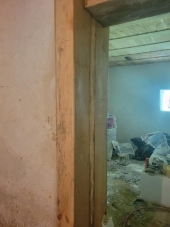The Humanure Handbook was a fascinating read. It really struck home to me when he pointed out that we're sh**tting in our drinking water when we use flush toilets, or words to that effect.
I live on the relatively treeless dry Prairie where water is valued and sawdust is not an option. I have found an excellent replacement with peat moss, which is inexpensive and can be bought by the bale at hardware stores and garden centres. We use about 12 bales a year at $7 a bale.
My first toilet was made for my 'tiny' guest house, using the 5 gallon bucket method. Being a guest house, I wanted it to look as 'respectable' as possible, so I used an old enclosed-style end table to make the toilet, with a hole cut in the top, toilet seat fastened on and the bucket inside easily accessed via the end table's double doors. (Pic to follow).
The bucket style toilet works so well I haven't bothered with any other method, and have by now made several others, including a very portable model for emergency situations.
My husband... um... 'poo-pooed' the whole thing until he was very ill and wasn't making it to the regular bathroom. So I made a composting toilet and put it in his room and he is a changed man now.
Last spring, our septic line plugged so (you guessed it) I made another and put it in the bathroom beside the unusable flush toilet and we used it all summer... three adults live here, and for 3 weeks I had an additional 12 family members staying with us... all using my bucket toilet. Including my 88 yr old mother.
We find these toilets so easy to use, clean, odorless and convenient that we each have a bucket toilet in our bedrooms to use at night. Each person is responsible for maintaining their own toilet, which is also convenient for me :)
The thing to remember about these toilets is, IF IT STINKS, YOU'RE NOT DOING IT RIGHT. Don't blame the toilet. You need to put about 4 inches of clean material in the bottom of the bucket before you start using it. You need to adequately cover with more material (in our case, peat moss) every time you go, whether it's poop or pee. I keep a 5 gallon pail of clean material at hand with a scoop for this purpose.
We put the used 'poopy' toilet paper in the toilet bucket along with the poop, but 'pee' toilet paper goes into a separate waste basket to be used as fire starter along with other papers.
With three people in the house, a 5 gallon bucket lasts about 5 to 7 days until it is full. Then I take out the bucket, put its fitted lid on, and set it in a designated spot outside, behind the house. Another bucket, with 4 inches of peat moss in the bottom, is put in place. I have 12 5-gallon buckets with their lids to use as "sleeves" for the toilets.
When ten buckets are full, about every two months, I take them over to the compost bins to empty. I built a double bin, each 4x8 ft, for this purpose. Ten buckets of dirtied peat moss can be dumped upside down in a double row across the bin, raked level, and then covered with about 6 inches of old straw. Once the straw covering is on, the bin odor is minimal at first and gone in a couple of days.
Once the buckets are emptied. I have a hose nearby to rinse, bleach, and rinse again. A final wipe around with a bleach soaked rag and the buckets and lids are stacked and stored ready for use again. Bleach keeps them sterile, attractively clean and white (like a toilet) and kills any odor retained by the plastic bucket. The whole process takes about half an hour, every two months.
Our septic is fixed now but, as a family, we decided to keep using the composting toilets.
.











